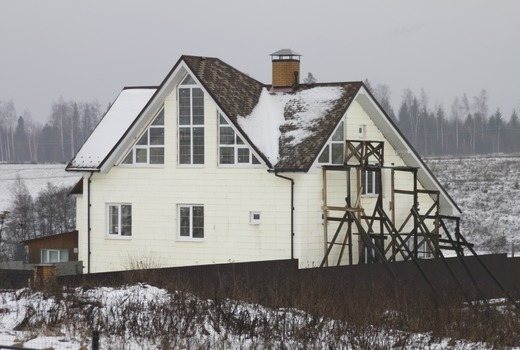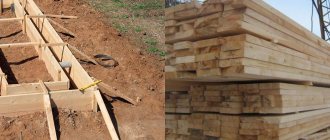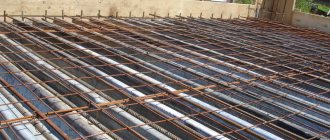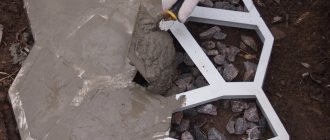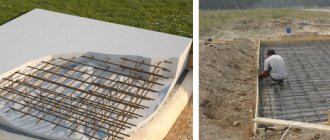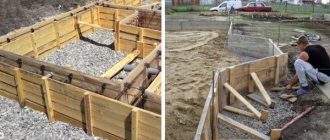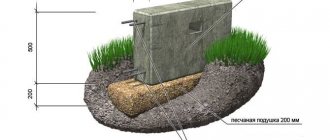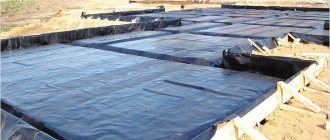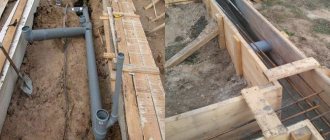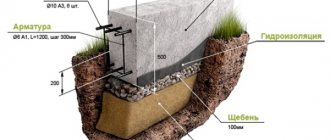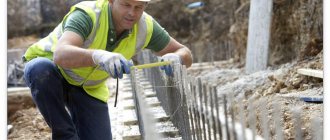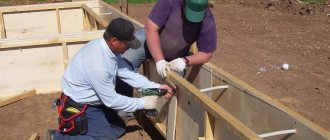If previously the formwork was first installed, and after the solution had completely hardened, it was dismantled, but now permanent formwork is becoming increasingly popular, which is becoming an integral part of the entire reinforced concrete structure. The undoubted advantage of this type of formwork is the high speed of installation (no time is spent on dismantling). It also acts as insulation for load-bearing walls of a building, which significantly increases the energy-saving qualities of any structure.
Permanent formwork - general information
Permanent formwork is a built-up shaped structure used in modern construction for the construction of foundations or load-bearing walls of some buildings.
Outwardly, it looks like a single, strong structure made of blocks or panels. After assembling the structure, a cement-sand mass is poured into its interpanel space, which, after hardening, forms a concrete frame monolithic foundation.
Insulation of the foundations of old houses
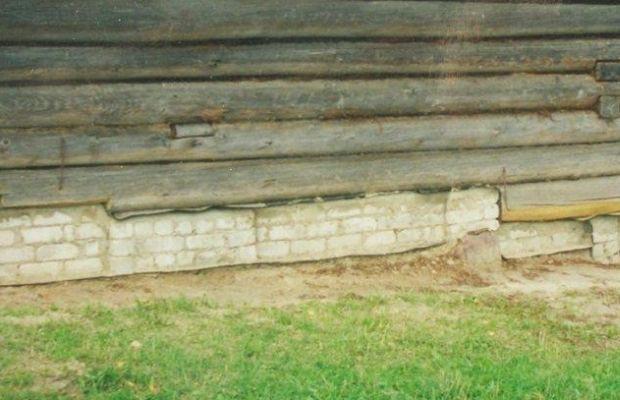
Insulation of the foundations of old houses
Often in villages you can find old houses that have no foundation in the modern sense of the word. The log houses were placed on several stones, slightly dug into the ground. Over time, such houses sagged and leaned, and one or more of the lower rows of the frame rotted. By the way, all bathhouses were built using this “simplified method” at that time. Is it possible to insulate the foundation of such a house and how to do it?
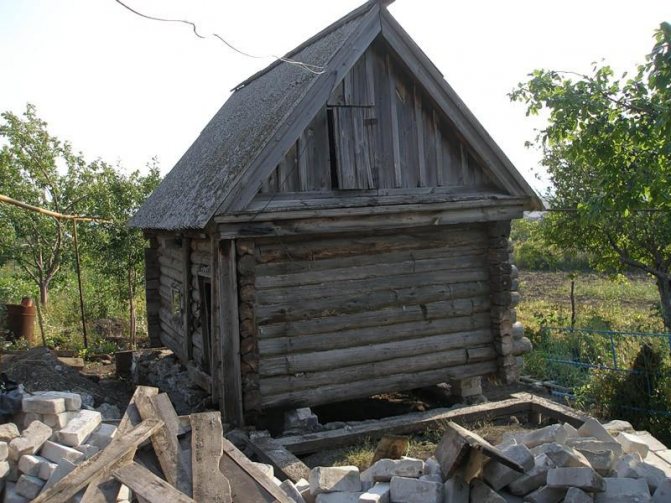
The foundation of the old log house needs to be repaired
First of all, the house needs to be jacked up and the rotten rows of the frame replaced. These works are complex; only real masters should undertake them. We will tell you what to do next with the foundation at the end of the article.
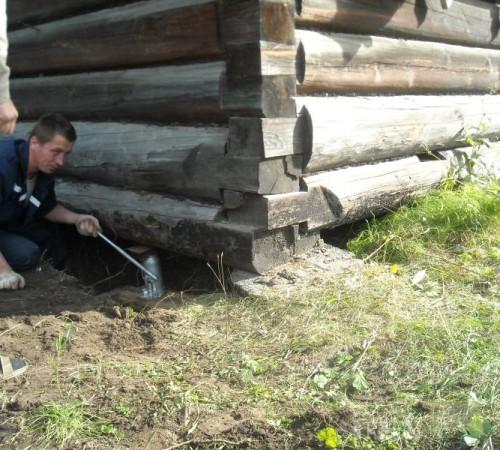
Loghouse foundation repair
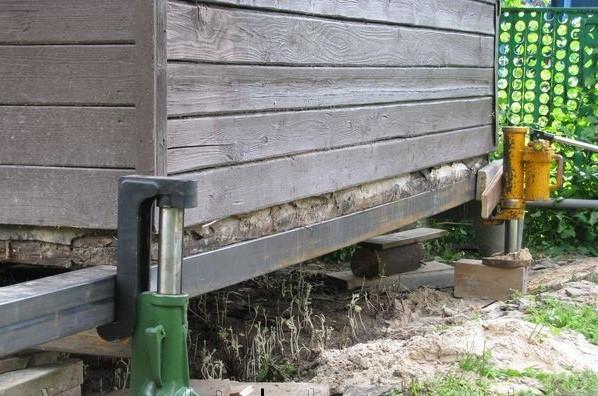
This is how they raise a house on jacks
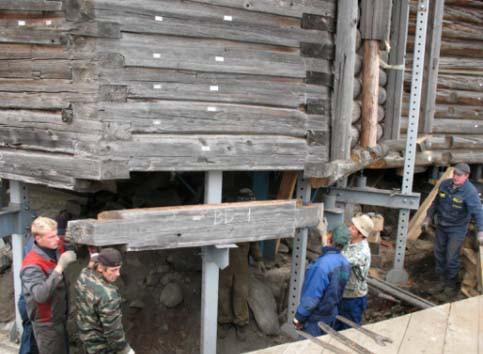
Replacing the lower crowns
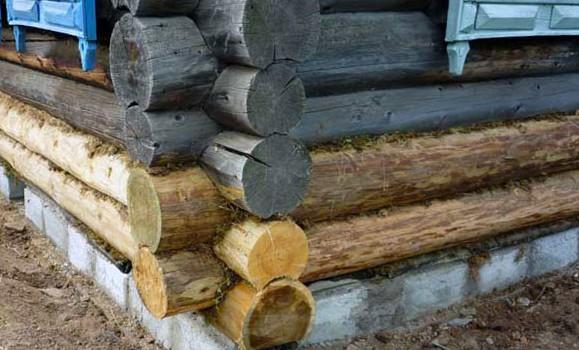
After the work has been completed. New lower crowns installed
The work shown in the next photo can hardly be called foundation insulation.

Insulating the foundation of an old house
It's more like patching holes with construction foam. How they will affect the improvement of the building’s heat saving performance, we do not undertake to judge. But we can say with confidence that the tree under the foam will rot at twice the speed.
Prices for liquid rubber for waterproofing
liquid rubber for waterproofing
Advantages of permanent formwork
The use of monolithic formwork in the construction, which allows you to create a strong, reliable foundation (or walls), has many worthy advantages:
— acceleration of the process of laying materials and building the necessary structures;
— lightening the overall weight of the structure due to the possibility of reducing wall thickness;
— providing excellent sound and heat insulation;
— permanent formwork can be used in almost any construction project - typical one- or multi-story residential buildings, complex retail and office structures, unusual sports and entertainment facilities, etc.;
- it is possible to use modern materials for such formwork (for example, wood concrete, reinforced polystyrene, expanded polystyrene) in any climatic conditions - there are no restrictions;
- decorative function - the formwork can have a structured or molded front surface, which will eliminate the need for additional decoration of the facade with special tiles or panels.
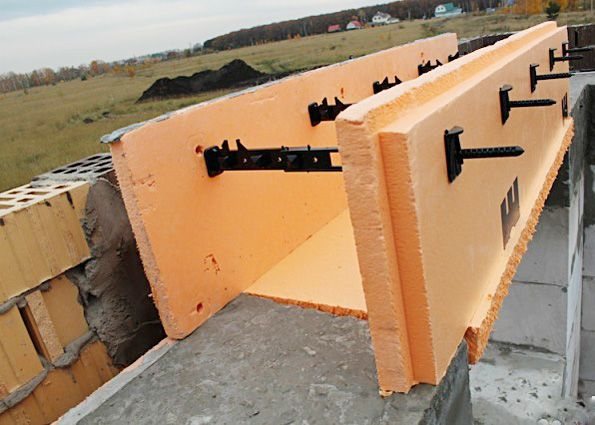
Types of permanent formwork
It was previously noted that permanent formwork, depending on the project, can be constructed from many different materials. The most commonly used are the following varieties:
1. Foamed polystyrene with internal voids - the material is presented in the form of layers (plate plates), connected into a solid structure using special jumpers. The structure being built resembles a Lego set, in which blocks are connected into a variety of large shapes. As a result, after pouring the cement-sand mass, monolithic polystyrene concrete is formed, which requires external (external) and internal finishing. The lining is mainly necessary to protect the material.
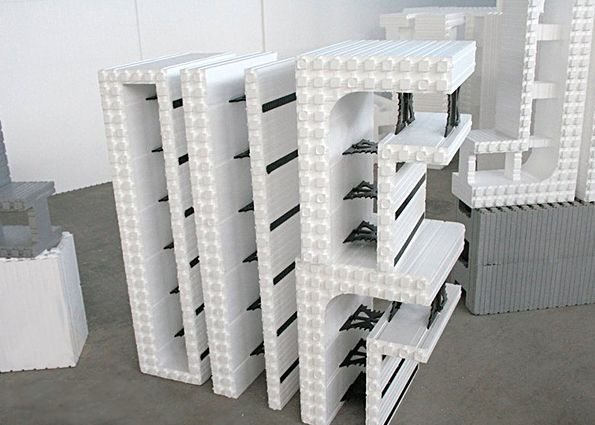
2. Armopanel - available in different versions - Paroc board, polystyrene foam or Rockwool, covered on both sides with a metal reinforced mesh.
During installation, concrete is poured under pressure between the panels. Once the solution has hardened, a kind of “sandwich panels” are formed, which are particularly durable. This construction method is considered to be low-budget, providing excellent performance. 3. Permanent decorative formwork is a structure characterized by the presence of a finished outer cladding. Its assembly is carried out using the method of seamless laying of special blocks.
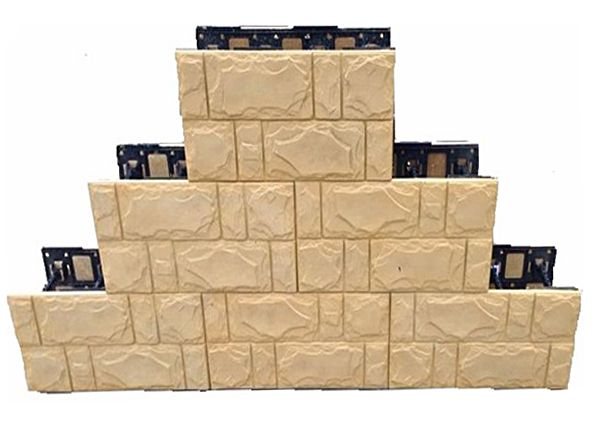
Important! In this version of permanent formwork, you need to put some kind of heat-insulating material (expanded polystyrene or layers of mineral wool) between the walls of the structure!
After preparing the formwork, concrete mixture is poured into it. The result is a monolithic, insulated concrete structure with decorative finishing.
4. Wood concrete (wood concrete panels or blocks) are slabs consisting of wood sawdust mixed with wood chips and cement. The formwork is assembled using ties, long screws and nails. Often, when building in a cold climate, a heat-insulating polystyrene foam liner is installed in it. Then reinforcement or other metal rods are placed and concrete-sand mortar is poured into the prepared structure.
The external surface requires decorative finishing with clinker, facade plaster, siding or natural stone. The inside can be finished with plasterboard or plaster mixture.
Insulation of foundations of operating buildings
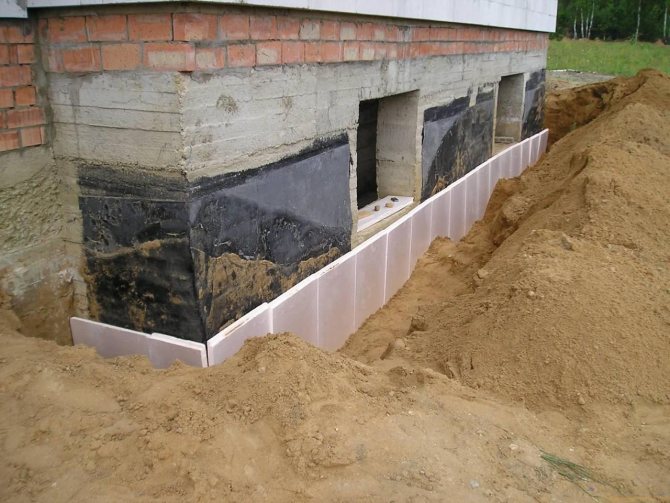
Insulation of foundations of operating buildings
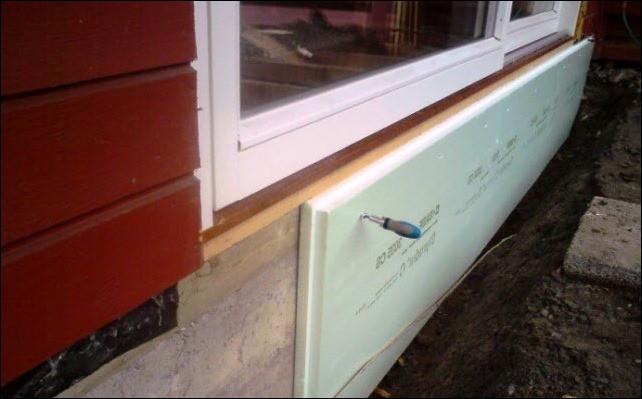
Insulation of the foundation of an existing house
A more complex case requires a significant amount of excavation work to be done manually. We will use polystyrene foam boards as insulation. We recommend using polystyrene foam for all types of insulation; among all its “brothers” it has the highest physical strength. The thermal conductivity of polystyrene foam is slightly higher, but the difference is so insignificant that it does not have any noticeable effect.

Technical characteristics of Styroplex® extruded polystyrene foam boards

Polystyrene foam size chart
Step 1. Assess the condition of the facility, think through issues with temporary storage of land. The work will continue for several days and there may be heavy rains. If problems with the ground and temporary drainage of rainwater are not thought through in advance, then flooding along the perimeter of the dug trench is inevitable. And this is very dangerous, waterlogged soil under the foundation strip sharply reduces its load-bearing capacity, the consequences can be extremely unpleasant.
Step 2. Remove the tiles around the house or dismantle the concrete blind area. It is much easier with tiles, but the blind area will have to be cut with a grinder and a diamond blade. Work with an angle grinder very carefully; it is one of the most dangerous tools. Moreover, his injuries were severe. Be prepared that while sawing the blind area there will be a huge amount of dust: close the windows in the house, if the facades have decorative plaster or are covered with wooden clapboard, then it is better to cover them with film.
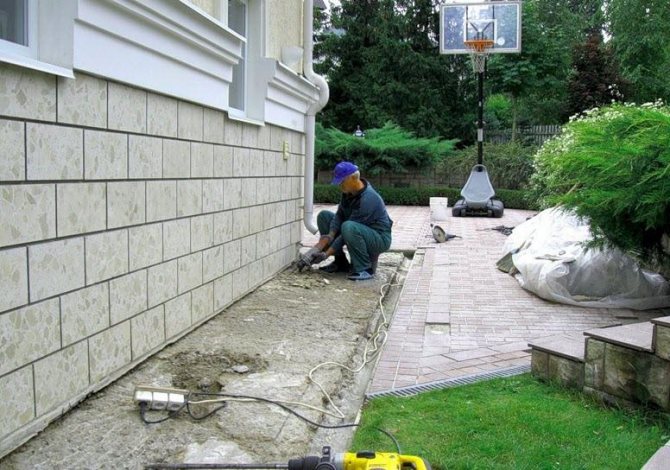
Dismantling the blind area Dismantling the blind area, breaking up old concrete
Step 3. Start digging a trench; the width of the trench should allow you to freely “handle” the shovel. If you do not remember the depth of the foundation, you will have to make a “test hole” and evaluate the condition and size of the foundation. This will help you draw up an optimal work plan and calculate the required amount of materials. Sometimes foundation strips are poured without formwork in the ground; the surface of the foundation is very uneven and it is not possible to correct it. In this case, there is an old method - insulation with expanded clay. The work is significantly simplified and cheaper, but the insulation efficiency is low.
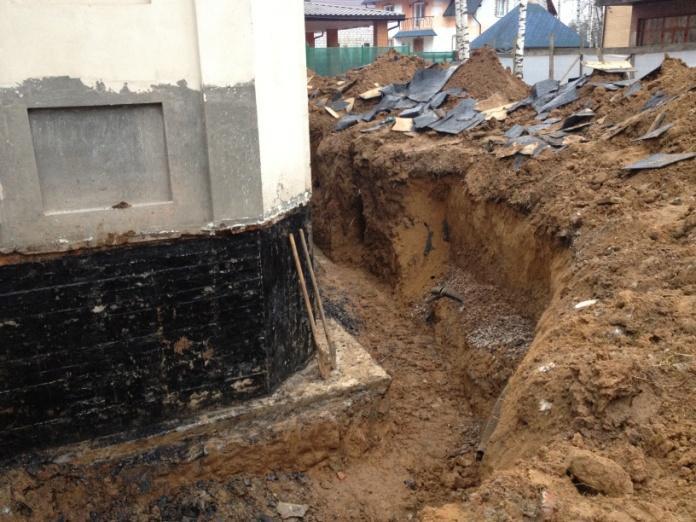
An example of a excavated pit near the foundation
Expanded clay needs to be poured into a trench along the entire perimeter of the building, pour 10 centimeters of sand on top and restore the original appearance of the blind area on it.
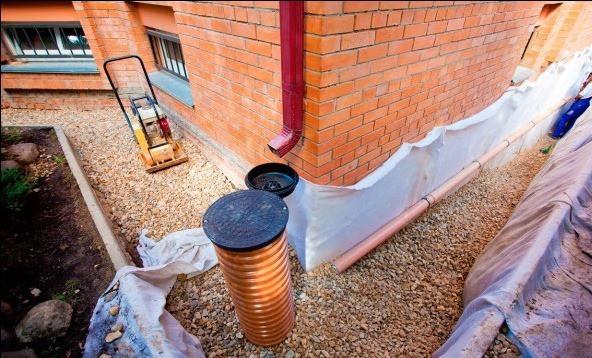
Example of filling expanded clay
Important. The fresh part of the blind area will definitely sag and become slightly lower than the old one.
There are three ways to solve the problem.
- The first is not to rush into the blind area, but to let the ground settle. This can be done if the building is not in use and it has a rainwater drainage system. It goes without saying that the length of the drain pipes must exceed the width of the dug trench.
- The second is to make the new blind area slightly higher than the old one. But we do not recommend restoring the blind area in this way; over time, its horizontal position may be significantly disrupted. It is much better to use paving stones in such cases; lay them in the vacant space. If necessary, it will not be difficult to remove several stones and align their position.
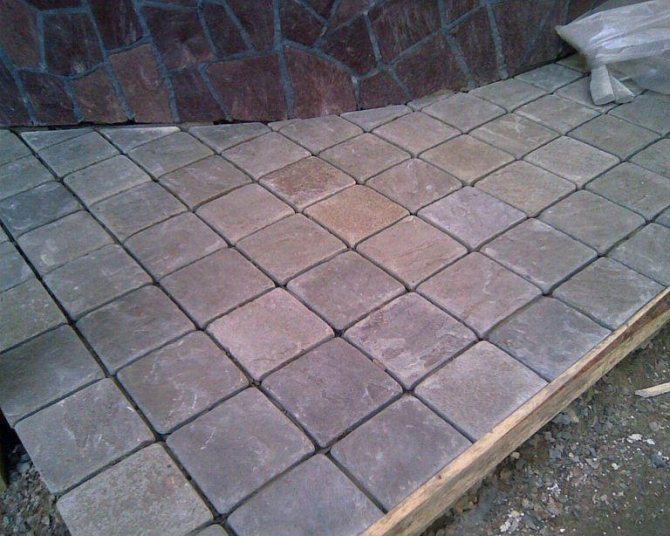
An example of a paving area
- There is another radical option - to remove the entire old blind area and make a new one. There is more work, but everything will be done reliably. Choose what you like.
Step 4. If the foundation walls are suitable for insulation with polystyrene foam, great. Let the surfaces dry a little, once dry, take a wire brush and carefully remove all remaining soil. Keep in mind that in the place where dirt remains, the glue will not hold the insulation.
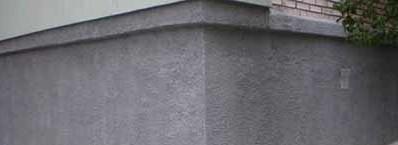
Prepare the foundation for insulation
Step 5: If possible, remove any large projections. Working in a narrow trench is inconvenient, but you will have to work hard. Small ones can be cut down with a chisel; for larger ones, you need to take a hammer drill.
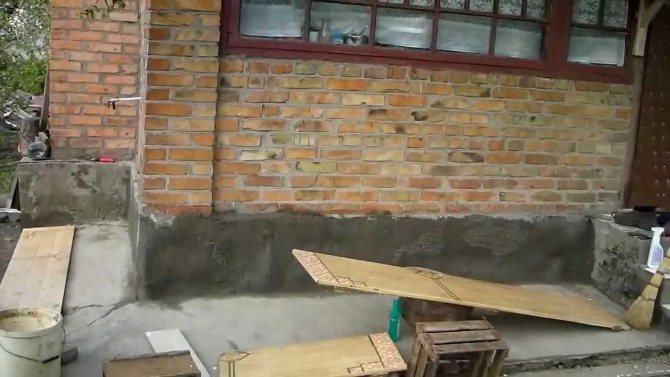
Level the surface. Knock down the bumps
Step 6 . Place the polystyrene foam boards on the glue, and check their position with a straight edge. The lath must simultaneously overlap at least two slabs, so you can place several insulation slabs in the same plane. If there are gaps, don’t worry, they are perfectly foamed with construction foam.
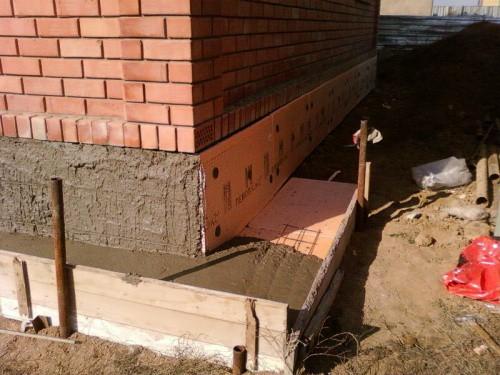
Laying insulation boards
Step 7: Backfill the trench. Do not pour the entire layer of soil at once, carry out the work in stages. In order to reduce the inevitable shrinkage of fresh soil, it must be compacted. You will not be able to compact the soil to a depth of more than 20–25 centimeters using improvised “pushes” and your own feet. Accordingly, this thickness of fresh soil must be added after compacting the previous one. It may take more time, but then you will have fewer problems.
It is strictly forbidden to pour water onto fresh soil or sand to tighten the compaction.
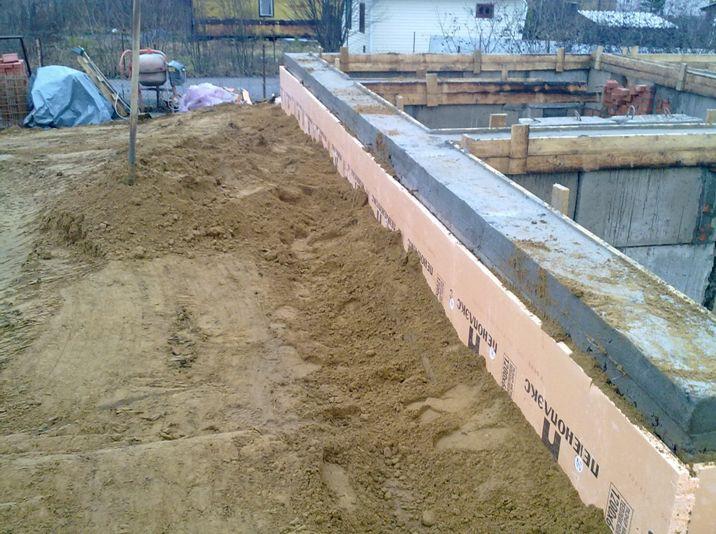
An example of backfilling a foundation with insulation
Prices for expanded clay
expanded clay
More information about polystyrene foam formwork
It’s worth stopping and considering the polystyrene foam version of permanent formwork, since it is the one that is most often used in construction today.
The key reason for its popularity is the simplicity and ease of installation of polystyrene foam boards. The work absolutely does not require the involvement of qualified specialists or any equipment. The block wall elements are firmly fastened together, and then concrete is poured into the formed space.
Various communications are laid in pre-designed technological openings. With this installation method, an insulated reinforced concrete wall with a monolithic structure is obtained.
This design does not require any additional sound or heat insulation work, since polystyrene foam performs such functions perfectly. In addition, the surface of this material does not absorb moisture and does not allow water vapor to pass through it at all. For a monolithic foundation with fixed polystyrene foam formwork, unfavorable weather is not a problem.
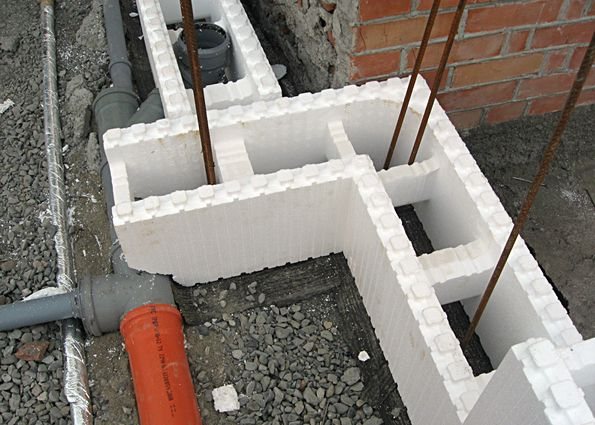
The advantages also include the resistance of expanded polystyrene to cracking and thermal structural expansion - that is, this technology can be used to build houses in hot, earthquake-prone regions.
The structure of permanent formwork, assembled from polystyrene foam boards, is simple and consists of the following parts:
— plastic ties;
— steel (galvanized) L-shaped hooks designed for strong fixation of plastic ties;
— external and internal facing decorative plates. They are made from concrete mixture and have a beautiful external structure.
When should you shoot?
begin dismantling at the moment when gaps appear between the concrete and the walls of the structure. This period can take from three days to two weeks: depending on the ambient temperature.
It is extremely important not to overexpose the formwork, since the boards may swell or, conversely, begin to shrink, creating unnecessary loads on the slab. All other work (waterproofing, insulation, cladding) is carried out within a month, when the concrete has reached its final strength state.
If dismantled panels are to be reused, they must be dried and checked to ensure they do not swell or bend. It’s easy to clean the canvas from concrete residues – just tap them a couple of times with a hammer.
General principles and features of installation of permanent formwork
The construction of a foundation using the technological method of permanent formwork is not difficult, although it consists of several successive stages, which are characterized by specific features. Let's look at them in detail:
Preparing land at a construction site
The created monolithic foundation, directly depending on the functional purpose of the building under construction, can be directly laid on leveled ground or in a dug trench. Although, regardless of the chosen method, during installation, under the lower surface of the foundation, a sand and gravel “cushion” with a thickness of more than 11.0 cm should be poured. Such a carefully compacted layer effectively compensates for the expansion of the soil and small displacements of its layers due to changes in temperature or changes in groundwater levels.
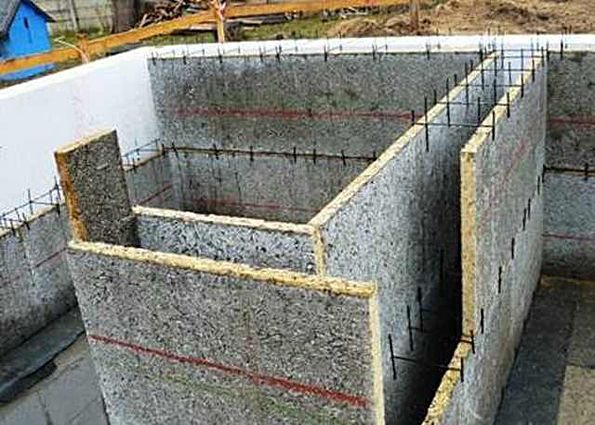
Installation of permanent formwork structure
Since the design process (design and installation) of permanent formwork is very simple, especially from polystyrene foam material, it is accessible even to untrained workers. The main thing is that the employee has minimal skills in construction and technological production.
Permanent formwork made of lightweight materials is installed according to the principle of a children's construction set or classic brickwork.
Preparation for construction
Before starting construction work, it is necessary to prepare the material that will serve as the basis of the structure:

fasteners,- props,
- tools.
In the case of wooden formwork, it is necessary to consider waterproofing, for example, prepare a plastic film.
To build panel formwork from wooden elements, you need to calculate the optimal thickness of the board.
The value of the parameter determines the load limit that the walls can withstand under the pressure of concrete. In order for an individual developer to calculate the minimum permissible board thickness, it is necessary to refer to SNiP.
A simplified formula for calculation is as follows:
d=√((0.75×G×k×I^2)/T),where
- G – load from concrete;
- k – vibrator coefficient;
- l is the distance between supports in meters;
- T is the permissible compressive strength of wood.
Formula for determining the load on the formwork walls that occurs under the pressure of the solution:
G=H×q,where
- H – height of the monolithic slab;
- q – volumetric mass of concrete (taken equal to 2500 kg/m3).
The value of the vibrator coefficient is generally equal to 1.2 or 1, if the concrete is not compacted using vibrating equipment. The permissible resistance of wood is 8x105 kg/m2. For reliability, the distance between supports is taken equal to 0.5 m.
The thickness of permanent formwork is selected according to the manufacturer’s recommendations. The sheet parameters will depend on the design loads and climatic conditions in the region.
Technology for assembling permanent formwork
The method of forming a permanent formwork structure involves performing the following sequence of actions, taking into account the fact that the site has already been prepared (see above):
— the outer plate is placed on a clean, flat surface with its outer (front) side;
Important! Clip-on locking nuts are inserted into the board material during production. They act as a base on which the steel hooks are attached!
— opposite blocks are fastened to each other using plastic ties. You can make your own screeds of any desired length, depending on the width of the foundation;
— the ties are secured to screwed-in hooks to level the interblock space;
— all permanent formwork is assembled into a single structure and the quality of the assembly is checked (evenness, stability, tightness of joints);
- then the space formed between the slabs is filled with a cement-sand mixture;
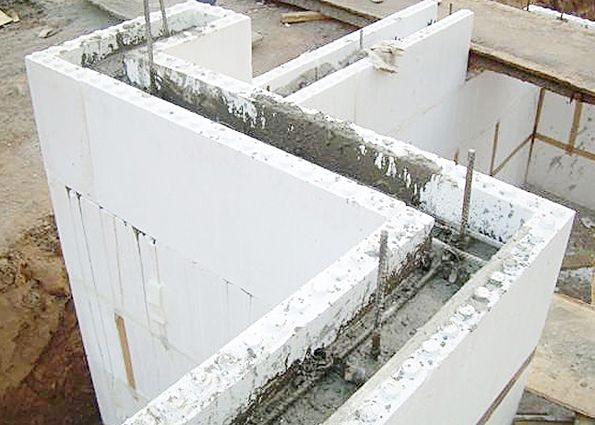
Warning! When pouring concrete, you should pay attention to the uniformity of its distribution over the entire area of the formwork space.
To ensure high-quality distribution of mass and prevent the formation of air cavities, you need to use a deep vibrator or control punctures of the poured mortar with long reinforcement throughout the entire depth of the foundation! - after the concrete has completely dried and set, you will get a specific “sandwich”. In it, a metal or plastic screed is placed between layers of insulation and decorative slabs, and everything inside the structure is fixed with durable concrete.
No further insulation or decorative finishing is required.
Finishing
Such work is necessary to improve the decorative effect of block modules and protect the formwork material from external influences. This applies not only to block varieties, but also to frame systems. Taking into account the fact that the surfaces are smooth, applying a thick layer of plaster is not required. It is enough to use a reinforcing mesh made of metal or fiberglass and glue.
In principle, the walls are strong enough to use stone material or ceramic tiles for finishing. Particularly popular for exterior finishing is siding, which is attached to the sheathing or directly into the monolith if the formwork system is made of plastic panels.
Today, some developers use decorative formwork structures that are faced with façade stone material. It should be noted that the cost of such a design is high, and it is not in high demand.
Internal work is also simplified. All that remains is to install a frame on the surface of the walls and cover it with plasterboard.
